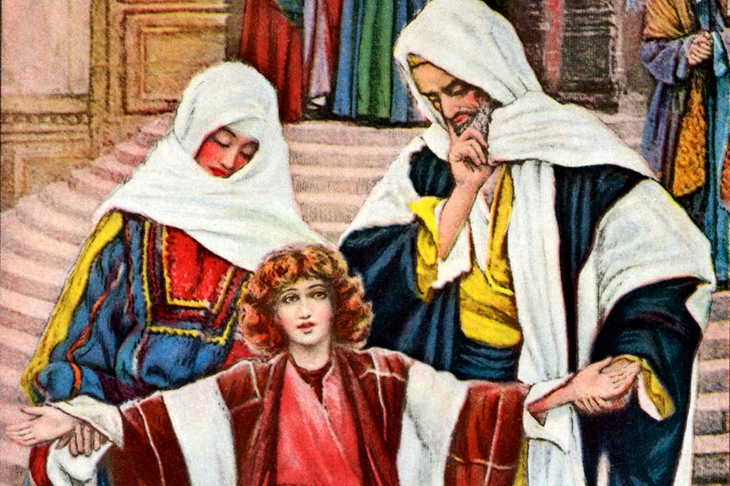Around 1 ad a 14-year-old Jewish Arab girl called Maryam, almost certainly in Nazareth in Galilee, gave birth to a son, Yeshua, (Joshua, Greek Iêsous, Latin Iêsus, Jesus). Typically of any such peasant family — the more the merrier — she added four more sons and at least two daughters to the tally. Some 30 years later, while he was being baptised in the Jordan, her first son heard a voice from heaven and his mission began. But what had he been doing in the meantime?
The Old Testament is full of advice about how to bring up a child. There may have been schools at this time, but the main responsibility fell on the family and community. Deuteronomy was the key text. There God’s law (tôrâ) made clear what sort of life the children of Israel should live and the teaching that would help them on the way. They were to understand the rules, the Ten Commandments, the covenant between themselves and God, and repeat and ask questions about the stories behind them (‘What does the Passover mean’?). There true understanding lay.
Two priorities emerged: first, to learn the fear of the Lord. This meant keeping the law and the commandments: from regular reciting, learning, praying, questioning within the family — adults and children alike — to attendance in the gathering-place (Greek sunagôgê, synagogue) where communal reading (also common market days) and teaching took place (worship was reserved for the Temple in Jerusalem). Second priority: teaching the children to honour parents and pay close attention to them. This was not mindless obedience but mutual, growing understanding between parent and child.
Other books also came into play. Proverbs was rich in advice: ‘Discipline your son, and he will give you rest; he will bring delight to your soul’; ‘train up a child in the way he should go and when he is old, he will not depart from it’. It is notable that ‘discipline’ (mûsar) also meant ‘instruction’ — for both children and parents.
All this puts in context the story of Jesus’s parents’ loss of him on the return from a Passover trip to Jerusalem when he was 12. His parents retraced their steps — enquiring in vain among friends and family on the same journey — and finally found him in the Temple, arguing impressively with learned men. As we have seen, this is what children were encouraged to do. Less impressed, his parents took him back to Nazareth and kept him there ‘in constant obedience/subjection to them’. Jesus was clearly an awkward 12-year-old, and this may have encouraged absurd later apocryphal stories, enormously popular with Christians, about his behaviour as a small boy with all power at his fingertips: those who hurt him dropped down dead, he often rebuked his father and so on (though when he wandered through woods, lions, wolves, panthers and other wild animals bowed reverently and showed him the way). His career as an itinerant preacher based in Capernaum (some think St Peter’s house has been found there) illustrates clearly enough that he continued to be a combative customer, certainly as far as the rich and powerful were concerned.
There is something else about his teaching that may draw on his early life. Galilee, bordered by Phoenicians to the north and Samaria and then Judaea to the south, was a fairly cosmopolitan area of ancient Palestine: apart from literary confirmation of a Jewish presence, archaeologists have found evidence of Syrian peoples, Phoenicians, Greeks and Romans, a mixed population confirmed by the Greek geographer Strabo, who added Egyptians.
Further, during this early period of Roman occupation the Galilean economy flourished, as the sheer diversity of goods found in villages across the region suggests. A complex network of routes made travel easy for salesmen dealing in luxury goods, and for Jesus and his followers, from Tyre and Sidon in the north to Judaea in the south. There is no reason why a family of carpenters from Nazareth should not have made a basic living out of it. Perhaps they even played some part in the rebuilding of the fine ancient city of Sepphoris, a few miles north-west of Nazareth, under the Rome-backed governor of Galilee Herod Antipas.
That wider world to which Jesus’s trade around cosmopolitan Galilee gave him access may be reflected in his mixing with publicans and sinners, his concerns about certain aspects of Judaism, his understanding of the plight of the poor and his broad vision of a many-mansioned kingdom of God.






Comments